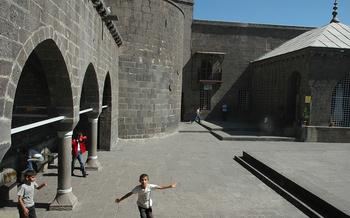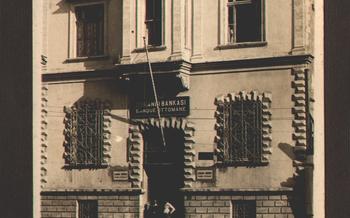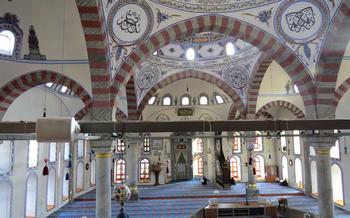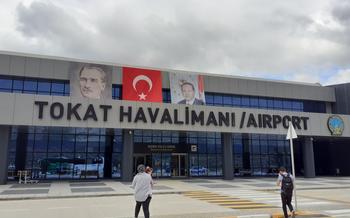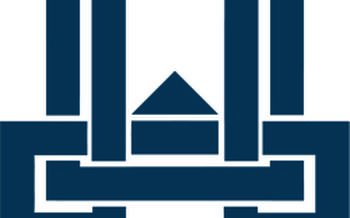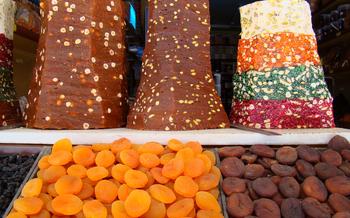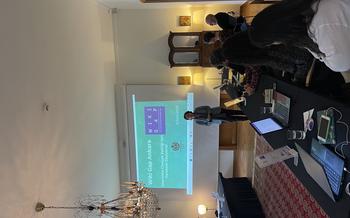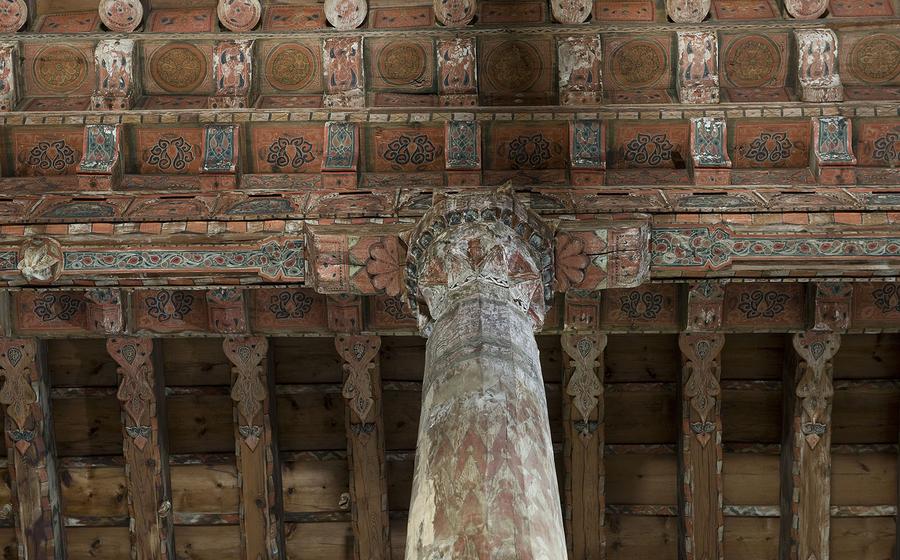
Kastamonu Mahmut Bey Mosque
- History of the Kastamonu Mahmut Bey Mosque:
- Location and Accessibility
- Visiting Hours and Admission
- Exploring the Mosque's Exterior
- Stepping Inside the Mosque
- The Mosque's Prayer Hall
- The Mosque's Mihrab
- The Mosque's Minbar:
- The Mosque's Chandeliers:
- The Mosque's Tilework:
- The Mosque's Courtyard
- The Mosque's Minaret:
- The Mosque's Library:
- Insider Tip
History of the Kastamonu Mahmut Bey Mosque:
Rooted in the heart of Kastamonu, the Kastamonu Mahmut Bey Mosque stands as a testament to the city's rich history and architectural splendor. Built in the 14th century by Mahmut Bey, the son of the Candarids, the mosque has played a pivotal role in shaping the city's cultural and religious landscape. Its unique architectural style blends Anatolian Seljuk and Ottoman influences, showcasing intricate tilework, elegant calligraphy, and stunning chandeliers that captivate visitors with their artistic prowess. The mosque's enduring legacy is deeply intertwined with the city's identity, serving as a symbol of its rich heritage and a beacon of spirituality for the local community.
Location and Accessibility
The Kastamonu Mahmut Bey Mosque is situated in the heart of the city of Kastamonu, Turkey. It is conveniently located within the city's old town, making it easily accessible to visitors exploring the historical center. To reach the mosque, one can take a leisurely stroll through the cobblestone streets, immersing themselves in the city's rich cultural heritage. Alternatively, public transportation options are available, with bus stops located within walking distance of the mosque. For those arriving by car, limited parking is available in the vicinity of the mosque. The mosque is wheelchair accessible, ensuring that visitors of all abilities can experience its architectural splendor.
Visiting Hours and Admission
The Kastamonu Mahmut Bey Mosque welcomes visitors from all walks of life, regardless of their religious beliefs. The mosque's doors are open throughout the week, from early morning until sunset. However, it is customary to visit during the designated prayer times to witness the mosque's vibrant atmosphere and the communal spirit. It is important to note that the mosque is closed to visitors during the five daily prayer times, as these periods are reserved for worshippers.
Admission to the mosque is free of charge, as it is considered a place of worship and not a tourist attraction. Visitors are encouraged to dress modestly and respectfully, adhering to local customs and Islamic traditions. While there is no strict dress code, it is advisable to cover your shoulders and knees, and women should cover their heads as a sign of respect.
Exploring the Mosque's Exterior
The Kastamonu Mahmut Bey Mosque stands as a testament to the architectural prowess of its time. Its exterior facade is a captivating blend of intricate details and impressive grandeur. As you approach the mosque, you'll be awestruck by its towering minarets, which seem to pierce the heavens. Their slender bodies are adorned with intricate carvings and designs, showcasing the skill and artistry of the mosque's builders.
The mosque's courtyard, with its serene ambiance, invites visitors to pause and reflect. Surrounded by arched walkways and adorned with vibrant tiles, the courtyard provides a tranquil space for contemplation and prayer. Take a moment to admire the intricate designs and patterns that adorn the courtyard's walls, each tile telling a unique story.
Stepping Inside the Mosque
Stepping inside the Kastamonu Mahmut Bey Mosque is like entering a realm of tranquility and spirituality. The vast interior of the mosque exudes an aura of serenity that envelops visitors as they cross the threshold. The layout of the mosque is simple yet elegant, with the prayer hall occupying the central space and the mihrab, minbar, and chandeliers adding to its grandeur.
The mihrab, the focal point of the mosque, is intricately carved with verses from the Quran, its niche adorned with colorful tiles and intricate designs. The minbar, used by the imam to deliver sermons, stands tall and majestic, its intricate carvings and geometric patterns a testament to the skill and artistry of its creators.
The chandeliers hanging from the high ceiling, a symphony of light and elegance, illuminate the mosque's interior with a warm glow. Their intricate designs, reminiscent of Ottoman artistry, add to the overall beauty and grandeur of the mosque.
The mosque's interior is further embellished with intricate tilework, covering the walls and niches with vibrant colors and patterns. These tiles, with their geometric motifs and floral designs, create a mesmerizing visual tapestry that captivates the eyes and inspires the soul.
The overall effect of the mosque's interior is one of harmony and balance, where every element contributes to the creation of a sacred and awe-inspiring space. It is a place where the faithful can come together to pray, reflect, and connect with their faith.
The Mosque's Prayer Hall
The prayer hall of the Kastamonu Mahmut Bey Mosque is a vast and awe-inspiring space, designed to accommodate a large congregation of worshippers. The intricate designs and patterns on the carpets add to the serene and spiritual atmosphere, creating a sense of tranquility and devotion. The qibla wall, which indicates the direction of Mecca, is adorned with beautiful calligraphy and intricate tilework, emphasizing its significance as the focal point of the prayer hall. The acoustics of the mosque are remarkable, allowing the voices of the imam and worshippers to resonate throughout the hall, creating a truly immersive and moving experience during prayers.
The Mosque's Mihrab
The mihrab, a sacred niche in the wall of a mosque indicating the qibla, the direction of Mecca, is an architectural masterpiece in the Kastamonu Mahmut Bey Mosque. Its intricate design and craftsmanship pay homage to the significance of the qibla in Islamic prayer.
The mihrab is adorned with exquisite tilework, featuring vibrant colors and intricate geometric patterns. Its central medallion, a symbol of divine presence, is surrounded by delicate floral motifs and calligraphy, creating a visually stunning focal point.
The mihrab's construction involved a combination of traditional techniques and innovative artistry. Skilled artisans employed a variety of materials, including ceramic tiles, marble, and mother-of-pearl, to achieve a harmonious blend of textures and colors.
Beyond its aesthetic beauty, the mihrab holds profound symbolism. Its pointed arch represents the path to spiritual enlightenment, while the inscriptions within it convey verses from the Quran and poetic expressions of devotion. The mihrab serves as a reminder of the connection between the physical and spiritual realms, inviting worshippers to focus their prayers and seek divine guidance.
The Mosque's Minbar:
The minbar, or pulpit, is a prominent feature of the Kastamonu Mahmut Bey Mosque, used by the imam to deliver sermons and religious teachings during prayers. It stands as a symbol of authority and guidance within the mosque. This particular minbar is renowned for its intricate carvings and decorations, showcasing the exceptional craftsmanship of its makers. Constructed using fine wood, the minbar features delicate floral motifs, geometric patterns, and calligraphic inscriptions that enhance its overall design. These intricate embellishments not only add to the aesthetic beauty of the mosque but also hold significant symbolic and religious meanings, reminding visitors of the mosque's rich Islamic heritage.
One interesting anecdote associated with the minbar is the story of a renowned calligrapher who was commissioned to inscribe verses from the Quran onto its surface. As he worked meticulously on the minbar, he accidentally spilled a pot of ink, leaving a dark stain on the wood. Instead of trying to conceal the mistake, the calligrapher skillfully incorporated the stain into his design, transforming it into a unique and eye-catching element that added to the minbar's overall charm. This story highlights the ingenuity and adaptability of the artisans who worked on the mosque, turning an unfortunate mishap into a beautiful work of art.
The Mosque's Chandeliers:
The Kastamonu Mahmut Bey Mosque is adorned with a breathtaking array of chandeliers, each a masterpiece of craftsmanship and design. Suspended from the high ceilings, these exquisite fixtures bathe the interior in a warm and ethereal glow, creating an atmosphere of serenity and reverence.
The chandeliers vary in size and style, from smaller, intricate pieces to grand, multi-tiered structures that cascade down from the ceiling like glittering waterfalls. The materials used range from gleaming brass and copper to sparkling crystal, reflecting the light in a mesmerizing display.
The designs of the chandeliers are as diverse as they are beautiful. Some feature intricate floral motifs, with delicate petals and leaves rendered in intricate detail. Others showcase geometric patterns, with interlocking circles, stars, and hexagons creating a sense of harmony and order.
The symbolic significance of the chandeliers is also profound. In Islamic architecture, light holds a special place, representing knowledge, guidance, and the divine presence. These chandeliers, with their radiant glow, serve as a reminder of the spiritual illumination that can be found within the mosque.
Moreover, the chandeliers are not merely decorative elements. They play a functional role in illuminating the mosque's interior, allowing worshippers to read the Quran and perform their prayers with ease. The soft, diffused light creates a welcoming and inviting atmosphere, fostering a sense of community and togetherness among the faithful.
Whether admired from afar or examined up close, the chandeliers of the Kastamonu Mahmut Bey Mosque are a testament to the skill and artistry of the craftsmen who created them. They are a harmonious blend of form and function, embodying the mosque's rich aesthetic heritage and its enduring spiritual significance.
The Mosque's Tilework:
The Kastamonu Mahmut Bey Mosque is adorned with exquisite tilework that showcases the artistry and craftsmanship of its creators. Every corner of the mosque, from the walls to the mihrab, is covered in intricate patterns, vibrant colors, and captivating motifs. The tiles are arranged in harmonious compositions, creating a mesmerizing visual feast for visitors. The designs range from geometric patterns to floral motifs, often incorporating verses from the Quran and the names of Allah and the Prophet Muhammad. The tilework also incorporates traditional Turkish motifs and symbols, reflecting the mosque's deep connection to its cultural heritage. The vibrant blues, greens, and reds used in the tiles create a sense of tranquility and spirituality, adding to the mosque's serene atmosphere. Each tile is meticulously handcrafted, and the attention to detail is evident in the intricate designs and patterns. Together, the tiles create a stunning tapestry that tells a story of faith, devotion, and artistic excellence.
The Mosque's Courtyard
The courtyard of the Kastamonu Mahmut Bey Mosque serves as a tranquil and inviting space for visitors to gather, contemplate, and connect with their spirituality. Designed in accordance with traditional Islamic architecture, the courtyard features a central fountain surrounded by lush greenery, creating a serene and refreshing ambiance. The fountain, with its gentle water flowing, adds a soothing element to the courtyard's atmosphere, inviting visitors to sit and reflect amidst the tranquil surroundings.
The courtyard's layout and design elements are both functional and aesthetically pleasing. Covered walkways line the perimeter of the courtyard, providing shelter from the sun and rain while allowing visitors to move around comfortably. The walkways are adorned with intricate tilework and decorative arches, adding a touch of elegance to the courtyard's overall appearance.
Beyond its practical function as a gathering space, the courtyard holds symbolic significance in Islamic architecture. It represents the transition between the secular world and the sacred space of the mosque. Visitors are encouraged to take a moment in the courtyard to cleanse themselves both physically and spiritually before entering the prayer hall, setting the tone for a meaningful and immersive worship experience.
The Mosque's Minaret:
The Kastamonu Mahmut Bey Mosque boasts a striking minaret that stands tall and proud, symbolizing the mosque's presence in the city's skyline. This towering structure serves as a beacon of faith, guiding the faithful to the mosque for their prayers. Built using traditional construction techniques, the minaret showcases intricate stonework and delicate ornamentation that reflect the mosque's architectural grandeur.
The minaret's design incorporates several unique features that set it apart from others in the region. Its slender form and graceful curves create a sense of elegance and lightness, while the intricate carvings and decorative elements add a touch of grandeur. The minaret's multiple balconies, each adorned with delicate balustrades, provide platforms for the muezzin to call the faithful to prayer with a resounding voice that echoes through the city streets.
The minaret's strategic placement ensures that the call to prayer can be heard from afar, inviting the community to join in the congregation for their daily prayers. It acts as a symbol of unity and a reminder of the mosque's vital role in the city's religious and cultural landscape.
The Mosque's Library:
Within the sacred confines of the Kastamonu Mahmut Bey Mosque, visitors can discover a hidden treasure – its tranquil and knowledge-filled library. This repository of wisdom houses a diverse collection of books and manuscripts, each representing a chapter in the rich history of Islamic scholarship. From ancient texts on theology and philosophy to contemporary works on science and literature, the library offers a haven for those seeking knowledge and spiritual enlightenment.
One of the unique features of the mosque's library is its collection of rare manuscripts, carefully preserved and protected within its walls. These manuscripts, meticulously handwritten by skilled scribes, contain invaluable insights into the intellectual pursuits and cultural heritage of past generations. Visitors can marvel at the intricate calligraphy, vibrant illuminations, and detailed illustrations that adorn these manuscripts, each a testament to the artistry and devotion of their creators.
The mosque's library also serves as a center for learning and contemplation, where scholars and students gather to engage in intellectual discussions and explore the depths of Islamic knowledge. Whether seeking guidance on religious matters, delving into historical texts, or simply finding solace in the written word, visitors to the mosque's library are sure to find a wealth of resources and inspiration.
One remarkable anecdote associated with the library tells of a young scholar who spent countless hours studying within its walls. Driven by an unquenchable thirst for knowledge, he immersed himself in the texts, absorbing their wisdom and insights. As the years passed, he became renowned throughout the region for his erudition and piety, and the mosque's library became synonymous with his legacy of scholarship and devotion.
Insider Tip
For a truly unique experience, plan your visit to the Kastamonu Mahmut Bey Mosque during one of the many religious festivals or special events held throughout the year. During these times, the mosque comes alive with celebrations, traditional music, and vibrant decorations, offering a glimpse into the city's rich cultural and religious heritage. Participating in these events allows visitors to connect with the local community, learn about Turkish customs and traditions, and witness the mosque's significance as a center of spiritual and cultural life in Kastamonu.


